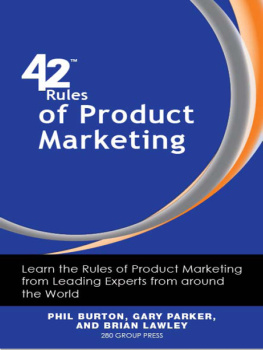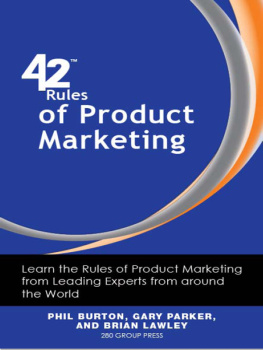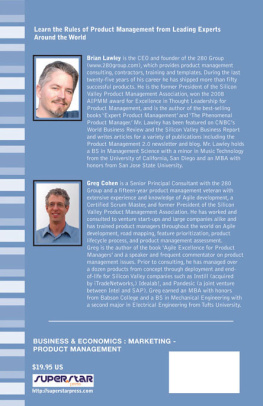42 Rules of Product
Marketing
Learn the Rules of Product
Marketing from Leading Experts
from around the World
By Phil Burton, Gary Parker,
and Brian Lawley

E-mail:
20660 Stevens Creek Blvd., Suite 210
Cupertino, CA 95014
Copyright 2012 by Phil Burton, Gary Parker, and Brian Lawley
All rights reserved. No part of this book shall be reproduced, stored in a retrieval system, or transmitted by any means electronic, mechanical, photocopying, recording, or otherwise without written permission from the publisher.
Published by Super Star Press, a Happy About imprint 20660 Stevens Creek Blvd., Suite 210, Cupertino, CA 95014
http://42rules.com
First Printing: March 2012
Paperback ISBN: 978-1-60773-080-4 (1-60773-080-4)
eBook ISBN: 978-1-60773-081-1 (1-60773-081-2)
Place of Publication: Silicon Valley, California, USA
Library of Congress Number: 2012932095
Trademarks
All terms mentioned in this book that are known to be trademarks or service marks have been appropriately capitalized. Happy About, nor any of its imprints, cannot attest to the accuracy of this information. Use of a term in this book should not be regarded as affecting the validity of any trademark or service mark.
Warning and Disclaimer
Every effort has been made to make this book as complete and as accurate as possible. The information provided is on an as is basis. The author(s), publisher, and its agents assume no responsibility for errors or omissions nor assume liability or responsibility to any person or entity with respect to any loss or damages arising from the use of information contained herein.
Praise For This Book!
42 Rules of Product Marketing provides unique insights on how to improve the effectiveness of product marketing investments and does an excellent job of collecting and organizing the best practices of thought leaders and experienced practitioners from a spectrum of product marketing functions.
Regardless of your role, organization, or background, you will gain new insights and ideas on how to improve the effectiveness of your product marketing activities.
Ken Horner, Vice President of Business Development, Calgary Scientific Inc.
42 Rules of Product Marketing is an excellent compilation of easy-to-read marketing tips that cover state of the art marketing practices and provide fresh perspectives and ideas to help any business move forward.
Mike Freier, President, Silicon Valley Product Management Association
I want to thank the authors of 42 Rules of Product Marketing for their contribution to the product marketing profession. They have created a powerful but concise book that pulls together the insights, experience, and wisdom of over 40 marketing professionals with excellent advice for both consumer and business products. This book is an excellent companion to 42 Rules of Product Management.
Therese Padilla, President, Association of International Product Marketing & Management
Dedication
This book is dedicated to the product marketing managers around the world, in every industry, who are committed to the success of their organizations by creating messages, customer collateral, sales tools, and everything else necessary to drive revenue for their companies products and services.
Acknowledgments
We would like to thank the outstanding team of product marketing experts worldwide who contributed their time and wisdom to this project. Without them, this book would not have been possible. By sharing their knowledge and insights, they have helped further the profession of product marketing.
We also want to express appreciation to our families for their support and patience during the creation of this book. We used to wonder why authors always dedicate books to their familiesnow we know!
Intro
Over our careers, we have watched as product marketing management (PMM) has evolved into a role that is absolutely vital to a companys success. Years ago, PMM functions, if done at all, were typically included in the product management (PM) role. The problem was the constant struggle between the need to develop market requirements for the engineering team against the equally important need for product launch, message creation, sales support etc. Often, short term deadlines for revenue demands from sales would take priority to the detriment of the companys longer range issues of product and market planning. By sheer necessity, companies around the world began to separate PMM from PM functions to achieve the right balance between the need to develop the product and the need to ensure its success in the marketplace after it was released. Establishing a PMM role meant that the sales teams could be assured of having a consistent, unified, and focused approach to messaging.
The PMM role has always been important, but it became absolutely critical with the advent of the Internet. As youll read in various Rules in this book, todays marketplaces are different because almost everything that buyers want to know about a company or product can be learned online. In the past, the sales team and the companys advertising would educate buyers in the early stages of the buying cycle. Essentially, the PR, advertising, and sales teams could manage the information available to buyers and users.
However, in todays Internet-based marketplace, with the rising importance of social media, savvy buyers expect to find the initial information for themselves from independent websites and from other customers, and dont want vendor contact until they are ready to buy. This means that the vital function of early prospect education has shifted dramatically and a PMM needs to utilize new marketing automation methodologies and tools to nurture leads until they are ready for the sales team to take them over.
Of course, despite all these changes, some basics never change. Product messaging is always about helping a prospect solve their business problem and address their needs, not simply describing product features. What has changed is how web-based messaging supplementsor in some cases replacesthe traditional product collateral so that the product marketing manager has to become a partner with the companys prospects in building a needed solution.
We are very fortunate that marketing experts from around the world took the time to share their insights on these very important topics. If youre like us, when you read their rules, youll find reminders of fundamentals that we all need to remember as well as fresh insights and approaches to vital aspects of your job.
We sincerely hope that the rules in this book will help make your product marketing career more enjoyable and more successful! Let us know your thoughts at http://280group.com/blog/.
Phil Burton, Gary Parker, and Brian Lawley
Rule 1
Rules Are Meant to Be Broken
By Gary Parker, Product
Marketing Manager, FalconStor Software
Never forget that the underlying driver is a passion to produce product messages that resound with our well-understood buyer personas.
This rule may seem unnecessary; after all, isnt the point of having rules to share and learn from other peoples experiences and research?
We believe this is a Zen type of statement that is telling us to balance in-depth marketing knowledge with the need to retain passion and creativity.
The late Steve Jobs was extraordinarily successful at breaking the rules and was famously quoted in Fortune for saying We do no market research. We just want to make great products. Taking his statement literally and ignoring the good advice from Rule 7 on market research would be a career threatening move for most of us and certainly has contributed to the high rate of start-up company failures.











